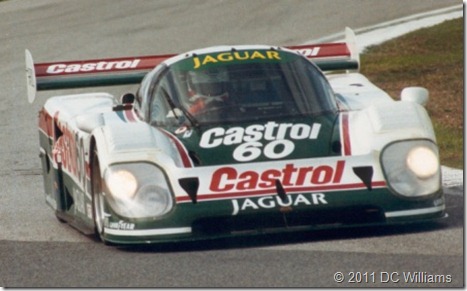Plain and simple: The Corvette DP is a game-changer, notwithstanding is whether it immediately goes faster than everything else.
For now.
Still, in an odd, ironic kind of way and after having taken a route that's stretched over nine racing seasons, the Daytona Prototype concept is "coming home" in its 10th season.
When former Grand-Am president Roger Edmondson in 2001 revealed the DP concept to this writer -- which at the time didn't even have an official name ("Daytona Sports Car" would be its first) -- one of the embryonic project's ambitious intentions was a desire to have everyday car owners relate to the future racing class through styling cues, primary among which were headlight and taillight lenses.
It's fair to say Porsche wasn't exactly thrilled with the whole DP styling-cue idea, but rarely is Porsche thrilled when something is outside of its hands, anyway.
Porsche has said, will say it's a matter of quality control. Others will, have countered (ask those whose association with Erwin and Manfred Kremer dates to the 1979 Le Mans) it's a matter of Porsche being able to make a buck or two. There's probably truth to be found in each, not that such shouldn't.
As those who were aware of those times have since conveyed, Porsche so lacked, um, enthusiasm for the DP concept that it supposedly threatened to shut off the parts-supply pipeline to those involved. That is, until someone noted that while countering clout could be exercised in new parts distribution channels, out in the wilds of America were thousands of junkyards from which sufficient parts quantities could be gathered.
Though Porsche's attitude became helpful in time, it remained antagonistic because even the Cayenne-based engines built by the Lozano Brothers came from a junkyard or through surreptitious means.
Oops.
On the domestic side, the DP which took the 2003 Rolex 24 At Daytona class crown was a "Ford Focus" fielded by Multimatic Motorsports and driven by Scott Maxwell, David Empringham and David Brabham.
Seeking to improve throttle response or "drivability" at the accelerator pedal which the three drivers pressed "to metal," changed was that proverbial 25-cent part -- though due to inflation the cost allowance probably should be around five bucks.
The three drivers -- Brabham, Empringham and Maxwell -- got their desired response but from a locally acquired spring that hadn't been previously tested at all on the (then only) Robert and Doug Yates-built engine, much less properly so.
Three springs, inconveniently placed, would snap and need replacement during the race. Alone subtract those laps lost in the pits replacing only the springs and a Ford Focus would've been entered in the history books as finishing ahead of all others in the 2003 Rolex 24.
Yet, despite Dearborn's officially approved name, the Multimatic Ford Focus effort immediately afterward all but entirely ground to a halt and languished to such an extent that precious developmental time passed quickly and irretrievably, making the Ford Focus DP an also-ran barely beyond its first race.
GM Racing, although willing to put its name Chevrolet name on valve covers and associated exterior car decals, was similar to Porsche in its not being thrilled to see a DP carry Corvette taillights and headlamps.
The Corvette, at the time, was only a handful of years into a relatively new program elsewhere and, reportedly, wasn't desirous of confusion arising.
At the same time GM didn't wish to offend those within the Grand-Am's topmost ranks who likewise had firm, similar connections to a very successful form of North American stock car racing.
The GM folks then said, "Let there be Pontiac," and between the 2004 Rolex 24 At Daytona's first practice day and race end, transformed within every GM-associated engine bay were Chevrolets to Pontiacs -- save one.
"No one's signed a contract with me yet," Jim Bell said after a reporter asked why his race-winning, Bell Motorsports-fielded No. 54 Kodak Doran JE4 still bore "Chevrolet" decals.
Car owner/driver Forest Barber, knowing drivers Andy Pilgrim, Christian Fittipaldi (who wasn't even listed on some official forms) and 2003 DP driving champ Terry Borcheller were sufficiently imbued with talent to have already carried the show, barely had enough time (or engine compression) to drive the DP's final 30-or-so minutes.
"Pontiac," at the time deemed GM's high-performance division as the guys in marketing would supposedly see it, offered a neat, clean way to escape fan confusion and for years to come keep happy the Grand-Am powers that be.
Yet, with the Chevrolet-to-Pontiac (and a similar Toyota-to-Lexus) switch came cries of woe heard from owners, who were reluctant to spend money merely for the sake of styling cues, and constructors, who noted that a seemingly simple headlight and taillight swap required engineering and associated expenses.
Though David Klym's FDSC/03 DP design was most associated with the Brumos Porsche Racing team, Darius Grala's Cegwa Sport chassis No. FDSC/03 004 "Toyota" had competed in eight of 2003's12 races and was expected to again undertake a limited 2004 schedule (eventually, three races).
"While a Lexus tail lamp might be an off-the-shelf part, the structure (the DP) into which it is mounted isn't," FABCAR's David Klym said in the changes' wake. "We've got to do everything from CAD (computer aided design) to making new molds before the first body part can even be produced."
Thus gone in 2004 due to practical considerations now reemerged, ironically in the "Corvette DP."
Later,
DC
